Science and Society & Change-Makers for a Better World
01/11/2014 18:00 (GMT+7) Font size:  
Boston, MA, USA, 31 October 2014 - Today, His Holiness the Dalai Lama was welcomed by his old friends, Richard Davidson and President of the Mind & Life Institute Arthur Zajonc as he arrived to take part in the 2nd International Symposium for Contemplative Studies (ISCS). In his introduction, Dr Davidson spoke of his feelings as he looked out at the audience of 1700 in the hall recalling how few were involved 27 years ago when he, Daniel Goleman and Francisco Varela began discussions that would become the Mind & Life Institute. Representatives of 23 countries were present today in a body of interested people twice the size of the first meeting of ISCS. His Holiness responded: 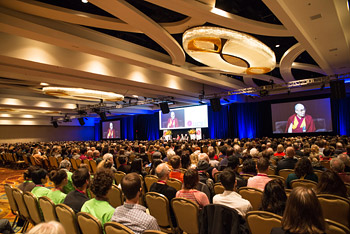
| An audience of over 1700 attending the International Symposium for Contemplative Studies with His Holiness the Dalai Lama organized by the Mind & Life Institute in Boston, MA, USA on October 31, 2014. Photo/Jurek Schreiner
|
“My respected, dear long-standing friends and colleagues, and all you other brothers and sisters. I always consider myself to be just one of 7 billion human beings, social animals, each of whose happy life depends on other members of the community. We are very much interconnected. And because of that I believe the many man-made problems we face can be eliminated. They arise out of our divisions into ‘us’ and ‘them’, and a lack of respect for the lives of others.
“I am a Buddhist monk. The Nalanda tradition I belong to follows the Buddha’s instruction not to accept his teaching out of faith and devotion, but as a result of investigation and experiment.”
He mentioned that the study of science has now been formally introduced into the curriculums of the Tibetan monastic universities re-established in South India. This is a part of a trend that began with his meetings with scientists, encounters that have been mutually enriching. Scientific findings today reveal the important role a calm and happy mind has on our physical health. He said:
“We aren’t talking about liberation or future lives; we’re talking about leading a happy life here and now.”
He also mentioned how in the past scientific developments employed in fearsome weapons systems have contributed to greater fear. Meanwhile, some people devoted to religion, which is supposed to bring about inner peace and harmony have continued to stir up trouble. Consequently, it is necessary to reconsider how to create a healthier, happier world. Of the 7 billion human beings alive today, there are at least 1 billion for whom religion no longer has much appeal, who may take interest in secular ethics. He declared he was looking forward to hearing what cooperation between science and spirituality had to offer, a statement that met with applause.
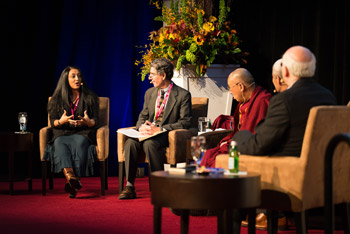
| Panelist Dr Amishi Jha speaking during the 2nd International Symposium for Contemplative Studies organized by the Mind & Life Institute in Boston, MA, USA on October 31, 2014. Photo/Jurek Schreiner
|
Dr Amishi Jha explained that when she decided, in 2004, to shift the focus of her work to what could be learned from contemplation, her advisers and colleagues were discouraging. She said only the Mind & Life Institute supported her decision. She asked His Holiness what led him to adopt a similar stance and how it had changed.
He replied that his interest in science dated back to his childhood. He would dismantle his toys to see what made them work. Similarly, trying to keep a generator that powered an old movie projector working taught him a great deal about the principles of electricity. In 1954-55 in China he visited factories, hydro-electric plants and steel works. As to how things have changed, he said as a Buddhist practitioner his aim is to serve others and to make an attempt to relieve their suffering. Too many have remained unaware that the source of true happiness is within us. Scientific findings, he agreed, had led to some aspects of Buddhist thinking becoming more realistic.
Richie Davidson asked if there remained any questions His Holiness felt were being neglected. His Holiness replied that he was interested to know what science might reveal about the distinction between sensory and cognitive experience. He remarked that everybody could employ Buddhist techniques to enhance the practice of compassion, but that discussions of emptiness remained Buddhist business.
“On the other hand,” he said, “if we were all to consider one another as members of one human family there would be no grounds for quarrelling and killing each other.”
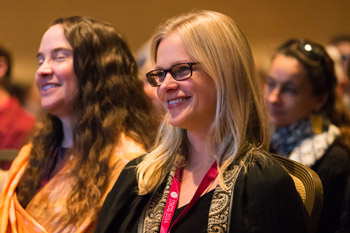
| Members of the audience attending the 2nd International Symposium for Contemplative Studies organized by the Mind & Life Institute in Boston, MA, USA on October 31, 2014. Photo/Jurek Schreiner
|
When Dr Davidson suggested that the boundaries between Buddhism and science were becoming more blurred, His Holiness described the content of the 300 volumes of Indian Buddhist literature translated into Tibetan under three categories: Buddhist science, philosophy and religion. He said that efforts to deal with philosophy and science over the last 20-30 years had attempted to bridge the gap between appearance and reality. Modern science knows a great deal about matter, for example with regard to impermanence and the momentary change that goes on constantly at an atomic level. Ancient Indian psychology, including Buddhist psychology, has an extensive understanding of the workings of the mind and emotions.
Dr Amishi Jha asked about secular ethics and how that relates to these shared fields of enquiry. His Holiness responded:
“Firstly, the ultimate source of happiness is here in the heart. To achieve it we need knowledge of mind and emotions. In order to draw up a curriculum of secular ethics we need a map of the mind. In addition to physical hygiene we need mental hygiene. We need to know what kinds of emotions yield what kind of feelings. Anger fear and hatred make us uncomfortable, whereas other emotions bring inner strength. It may take academic study to establish what mental hygiene should consist of. We have seen, for example, that inner happiness is good for our overall well-being, which can be of benefit to all 7 billion human beings. This involves voluntary mental transformation.”
Dr Jha observed that many people only encounter secular ethics at the workplace. His Holiness commented that any human activity related to inner peace is ultimately concerned with human well-being. Richie Davidson added that scientists want to be able to measure warm-heartedness and compassion, but have not yet developed the means to do so. His Holiness agreed that measurement is difficult but said there is discussion of the behavioural signs of mental development, much as we infer the existence of fire by smoke or the presence of fish in water from the ripples on its surface. Since inner strength is often only revealed in response to difficulties, he asked if that meant there was a need to make trouble for the people they were examining. He joked that a simpler approach might be to develop clairvoyance.
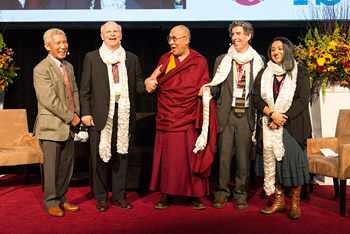
| His Holiness's interpreter Thupten Jinpa, and panelists Arthur Zojonc, His Holiness the Dalai Lama, Richard Davidson and Amishi Jha at the conclusion of the 2nd International Symposium for Contemplative Studies organized by the Mind & Life Institute in Boston, MA, USA on October 31, 2014. Photo/Jurek Schreiner
|
His Holiness mentioned that there can be some self-assessment.
“In my case, if I compare my responses to certain objects now to my response 30-40 years ago, there has been much change. In a discussion with an Indian practitioner in Bangalore a couple of years ago, we agreed that we had ethics, concentration and wisdom in common. What differentiated us was that his practice was based on a sense of atman or self, whereas my Buddhist practice was based on anatman, or the absence of any such self; but that’s our own business.”
Dr Jha reported that the previous evening there had been extensive discussion of climate change and asked His Holiness to comment. He said he did not know what to say, but noted the role of trees in the Buddha’s life. He was born under a tree, he attained enlightenment under a tree and he passed away beneath a tree. Monastic groups would move from one retreat to another and among the incoming group’s responsibilities was caring for and watering the saplings planted by their predecessors. There were also strictures about not polluting the water supply. All of these considerations have an environmental aspect.
“This is our only home; if we destroy it what are we going to do? Where can we go?”
The session was concluded with the presentation of a gift to His Holiness of the first copy of an elaborate book reproducing murals in Tibet created by Thomas Laird with text by Robert Thurman.
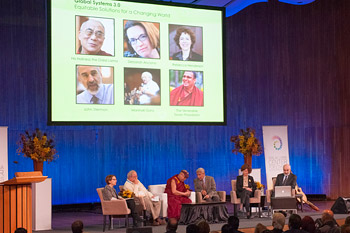
| The first panel discussion on Global Systems 3.0: Equitable Solutions for a Changing World organized by The Dalai Lama Centre for Ethics and Transformative Values at MIT's Kresge Auditorium in Cambridge, MA, USA on October 31, 2014. Photo/Brian Lima
|
In the afternoon, at the Kresge Auditorium, MIT, His Holiness participated in two panels under the theme ‘Change-Makers for a Better World’ organized by the Dalai Lama Center for Ethics and Transformative Values. The first panel, examining Equitable Solutions for a Changing World looked particularly at climate change. Deborah Ancona the moderator stated that the same question had been discussed in the same place two years ago, concluding that each of us needs to take a lead.
“Governments don’t do what’s necessary and we don’t do enough.”
John Sterman looked at the statistics and asserted that 2100 is not far away. If we want to prevent disaster we have to act now. Rebecca Henderson was optimistic about steps that can be taken in terms of more efficient use of energy and falling costs of alternative energy sources. She concluded that if we decide to make a difference, we can. Marshall Ganz said it would need leadership of hands, head and heart. What is required is a sense of moral urgency of the kind Rosa Parks showed in the Civil Rights struggle.
His Holiness confirmed the importance of the problem, noting that it is not as if it only affects one or two continents. It concerns all 7 billion human beings. He said:
“My concern is with the whole world. I am just a Buddhist student, but the emphasis of my practice is an altruism that must be translated into action. This kind of meeting should be held more often to raise public awareness. A lot of misplaced attitudes are the result of ignorance. The public must be informed not only of what the problem is, but also what can be done about it.”
Marshall Ganz stressed that non-violence does work, as Mahatma Gandhi and Martin Luther King Jr have shown. Rebecca Henderson reported a commercial ski company that took successful legal action over CO2 emissions. Illustrating the opposition to change Ganz quoted a story in the New York Times that reports a fossil fuel corporation spokesman saying:
“You gotta play dirty to win!”
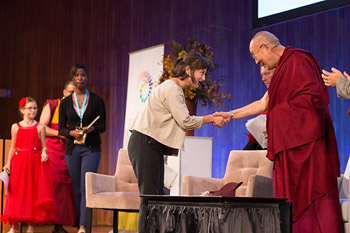
| Young panelists arriving on stage to take part in a conversation with His Holiness the Dalai Lama as part of the SPARK 2014 program organized by the Dalai Lama Center for Ethics and Transformative Values at MIT's Kresge Auditorium in Cambridge, MA, USA on October 31, 2014. Photo/Fredo Durand
|
The second panel on ‘Start a Spark’ featured youth in conversation with His Holiness. Jacarra Garraway first recited a poem full of hope and inspiration before asking His Holiness what piece of advice he received as a young adult that he still remembers. His answer recounted the affection he had received first from his mother and later from the servants with whom he played as a child. Noa Machera wanted to know where to find hope today. His Holiness recounted many ways in which he feels there is ground for optimism and hope, among them the increasing interest in peace rather than war.
He recalled asking the British Queen Mother whether the world was getting better or not, when she was 96 in 1996 and had seen most of the 20th century. She was unhesitating in telling him the world was getting better, saying that when she was young there was no talk of human rights or self-determination as there is today. Since the 20th century was an era of such violence, His Holiness is very keen that steps are taken to make the 21st century an era of dialogue instead.
Ten year old Vivienne Harr said that as far as she was concerned compassion isn’t compassion without action and asked for His Holiness’s advice. He recommended being open and warm-hearted. His concluding advice was:
“You, members of the younger generation, are the only hope for the future. Please think seriously about what we’ve talked about. Look at things from a wider perspective, taking a long view. We cannot change the past, but you can shape the future.”  http://www.dalailama.com/
|